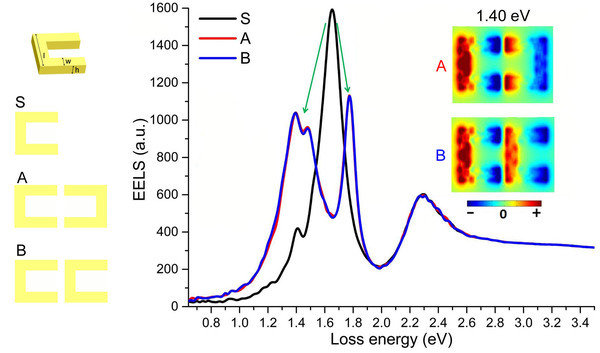Numerical investigation of hybridization in coupled split-ring resonators
Metamaterials are artificial structures composed of man-made elements that exhibit a number of astonishing properties that are not available in natural materials, such as artificial magnetism at optical frequencies [1]. As one prototype of an individual element in magnetic metamaterials, the split-ring resonator (SRR) has attracted a lot of interest [2].
A better understanding of the electromagnetic interactions between elements will facilitate the design of high performance metamaterials. So far, most studies on the coupling effects in metamaterials rely on optical far-field methods, which can only detect the bright modes that efficiently radiate into the far-field. However, the dark modes play an important role for the coupling of quantum emitters to metallic nanostructures. The combination of electron energy-loss spectroscopy (EELS) and scanning transmission electron microscopy (STEM) allows us to visualize different plasmonic modes of SRRs in response to the evanescent electric field.
In this project, we study several specific configurations of coupled SRRs, to investigate the plasmonic hybridization effect in metamaterials. In each configuration, several electron trajectories are considered to give enough data to accurately perform a modal decomposition analysis. The numerical calculations are performed in the framework of the discrete dipole approximation [3].
We observe that the plasmonic modes of the individual SRRs hybridize when two SRRs are in a coupled configuration. The fundamental, second and third order plasmonic modes are split into anti-symmetric and symmetric modes in the coupled SRR structures, with a strong effect of the SRR orientation. EELS has been shown to be a very accurate method for investigating the hybridization effect with the ability to perform a selective investigation of modes of different orders.
[1] S. Linden, C. Enkrich, M. Wegener, J. Zhou, T. Koschny, C. M. Soukoulis, Science 306 (2004) 1351
[2] J. Pendry, A. Holden, D. Robbins, W. Stewart, IEEE Trans. Microwave Theory Tech., 47 (1999) 2075
[3] N. Geuquet, L. Henrard, Ultramicroscopy, 110 (2010) 1075
This research has received funding from the European Union Seventh Framework Programme [FP7/2007-2013] under grant no. 312483 (ESTEEM2).


